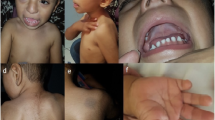Summary
A severely growth-retarded female newborn is described, who died a few hours after birth. About half of the clones and metaphases from an amniotic fluid cell culture (set up at the 3th week of gestation) and only 1/27 of the metaphases from a blood lymphocyte culture contained an additional No. 22 chromosome. Abnormal findings in the patient included a complex congenital heart defect, membranous anal atresia without fistula, distal limb hypoplasia, partial cutaneous syndactyly between second and third toes, and a left preauricular pit. On the basis of this case and other reports from the literature arguments for and againts the existence of full human trisomy 22 are discussed. the conclusion seems likely, that full trisomy 22 usually presents a lethal condition in man, though at present an occasional survival cannot be excluded.
Similar content being viewed by others
References
Aurias A, Prieur M, Dutrillaux B, Lejeune J (1978) Systemic analysis of 95 reciprocal translocations of autosomes. Hum Genet 45:259–282
Berger R, Lejeune C, Paillerets F de (1976) La trisomie 22. A propos d'une nouvelle observation. Ann Pédiat 23:705–711
Boué J, Daketsé M-J, Deluchat C, Ravisé N, Yvert F, Boué A (1976) Identification par les bandes Q et G des anomalies chromosomiques dans les avortements spontanés. Ann Génét (Paris) 19:233–239
Cervenka J, Hanson GA, Franciosi RA, Gorlin RJ (1977) Trisomy 22 with “cat eye” anomaly. J Med Genet 14:288–290
Creasy MR, Crolla JA, Alberman ED (1976) A cytogenetic study of human spontaneous abortions using banding techniques. Hum Genet 31:177–196
Farah LMS, Nazareth HR de S, Dolnikoff M, Delascio D (1975) Balanced homologous translocation t(22q22q) in a phenotypically normal woman with repeated spontaneous abortions. Hum Genet 28:357–360
Fried K, Bukovsky J, Rosenblatt M, Mundel G (1974) Familial translocation 15/22. A possible cause for abortions in female carriers. J Med Genet 11:280–282
Fryns JP, Jaeken J, Berghe H van den (1979) Partial trisomy 22q with elevated arylsulfatase-A activity. Ann Genet (Paris) 22:168–170
Hirschhorn K, Lucas M, Wallace I (1973) Precise identification of various chromosomal abnormalities. Ann Hum Genet 36:375–379
Iselius L, Faxelius G (1978) Trisomy 22 in a newborn girl with multiple malformations. Hereditas 89:269–271
Jenkins MB, Davis E, Thelen TH, Boyd L (1974) A familial X-22 translocation with an extra X chromosome. Am J Hum Genet 26:736–745
Kim HJ, Hsu LYF, Goldsmith LC, Strauss L, Hirschhorn K (1977) Familial regions of chromosomes 13 and 22 are responsible for the phenotype of each trisomy. J Med Genet 14:114–119
Lalchev S, Tzancheva M, Markova R (1978) A case of trisomy 22 with a probable Robertsonian translocation 21/22. Hum Genet 45:219–223
Lewis BV, Ridler MAC (1977) Recurrent abortion associated with a balanced 22;22 translocation, or isochromosome 22q in a monozygous twin. Hum Genet 37:81–85
Maeda T, Ohno M, Shimada N, Nishida M, Jobo T (1976) A 22/22 translocation carrier with recurrent abortions demonstrated by a Giemsa banding technique. Hum Genet 31: 243–245
Mameli M, Cardia S, Milia A, Seabright M (1978) A further case of 22;22 Robertsonian translocation associated with recurrent abortions. Hum Genet 41:359–361
Mangold B, Müller W, Hochleitner M, Rosenkranz W (1976) Zytogenetische und klinische Untersuchungen einer Patientin mit einer Trisomie 22. Paediatr Paedol 11:504–510
Mollica F, Sorge G, Pavone L (1977) Trisomy 22 mosaicism. J Med Genet 14:224–225
Mutchinick O, Ruz L, Jiménez R (1978) Partial trisomies 13 and 22 due to nondisjunction of a maternal reciprocal translocation, t(13;22)(q22;q11). Hum Genet 45:89–95
Neu RL, Valentine FA, Gardner LI (1975) Segregation of a t(14q22q) chromosome in a large kindred. Clin Genet 8: 30–36
Osztovics M, Ivády G (1977) A case of 22-trisomy mosaic. Acta Paediatr Acad Sci Hung 18:197–200
Pagon RA, Hall JG, Davenport SLH, Aase J, Norwood TH, Hoehn HW (1979) Abnormal skin fibroblast cytogenetics in four dysmorphic patients with normal lymphocyte chromosomes. Am J Hum Genet 31:54–61
Penchaszdeh VB (1979) Familial segregation of a reciprocal translocation (13;22)(q22;q11) in a kindred and an offspring with distal 13q trisomy. Am J Hum Genet 31:107A
Pérez-Castillo A, Abrisqueta JA, Martin-Lucas MA, Goday C, del Mazo J, Aller V (1975) A new contribution to the study of 22 trisomy. Hum Genet 30:265–271
Schinzel A (1981) Incomplete trisomy 22. II. Familial trisomy of the distal segment of 22q in two brothers from a mother with a translocation, t(6;22)(q27;q13). Hum Genet 56:263–268
Schinzel A, Schmid W, Fraccaro M, Tiepolo L, Zuffardi O, Opitz JM, Lindsten J, Zetterqvist P, Enell H, Bacichetti C, Tenconi R, Pagon RA (1981a) The “cat eye syndrome”: Dicentric small marker chromosome probably derived from a No. 22 (tetrasomy 22pter→q11) associated with a characteristic phenotype. Report of 11 cases and delineation of the clinical picture. Hum Genet (in press)
Schinzel A, Schmid W, Auf der Maur P, Moser H, Degenhardt KH, Geisler M, Grubisic A (1981b) Incomplete trisomy 22. I. Familial 11/22 translocation with 3:1 meiotic disjunction in malformed offspring. Delineation of a common clinical picture and report of eight new cases from six families. Hum Genet 56:249–262
Schmid W (1975) A technique for in situ kayrotyping of primary amniotic fluid cell cultures. Hum Genet 30:325–330
Schwinger E (1973) Translocation 22/22? Lancet II:854–855
Welter DA, Scharff L, Teal NM, Theavaos TG (1978) Trisomy 22 in a 20-year-old female. Hum Genet 43:347–351
Author information
Authors and Affiliations
Rights and permissions
About this article
Cite this article
Schinzel, A. Incomplete trisomy 22. Hum Genet 56, 269–273 (1981). https://doi.org/10.1007/BF00274677
Received:
Published:
Issue Date:
DOI: https://doi.org/10.1007/BF00274677




